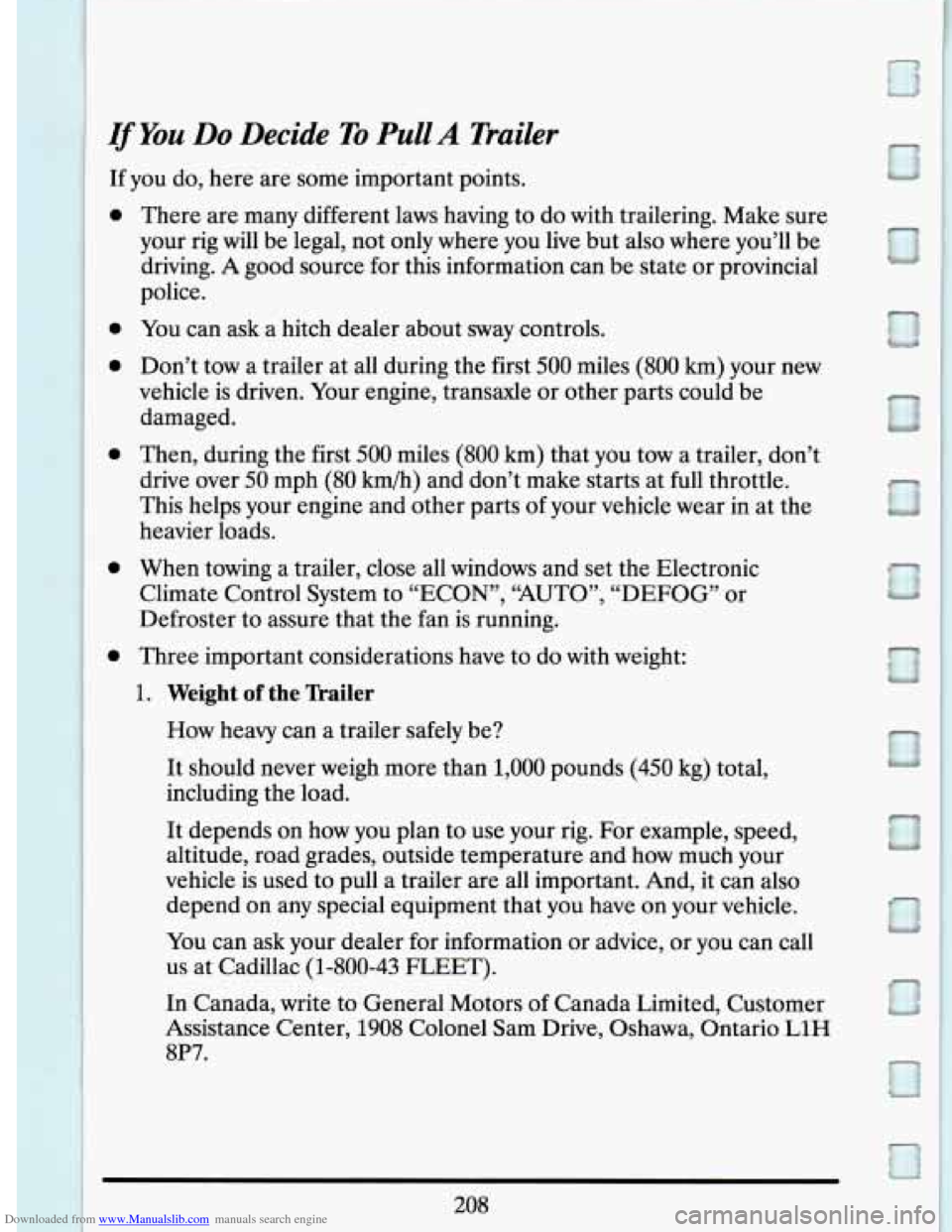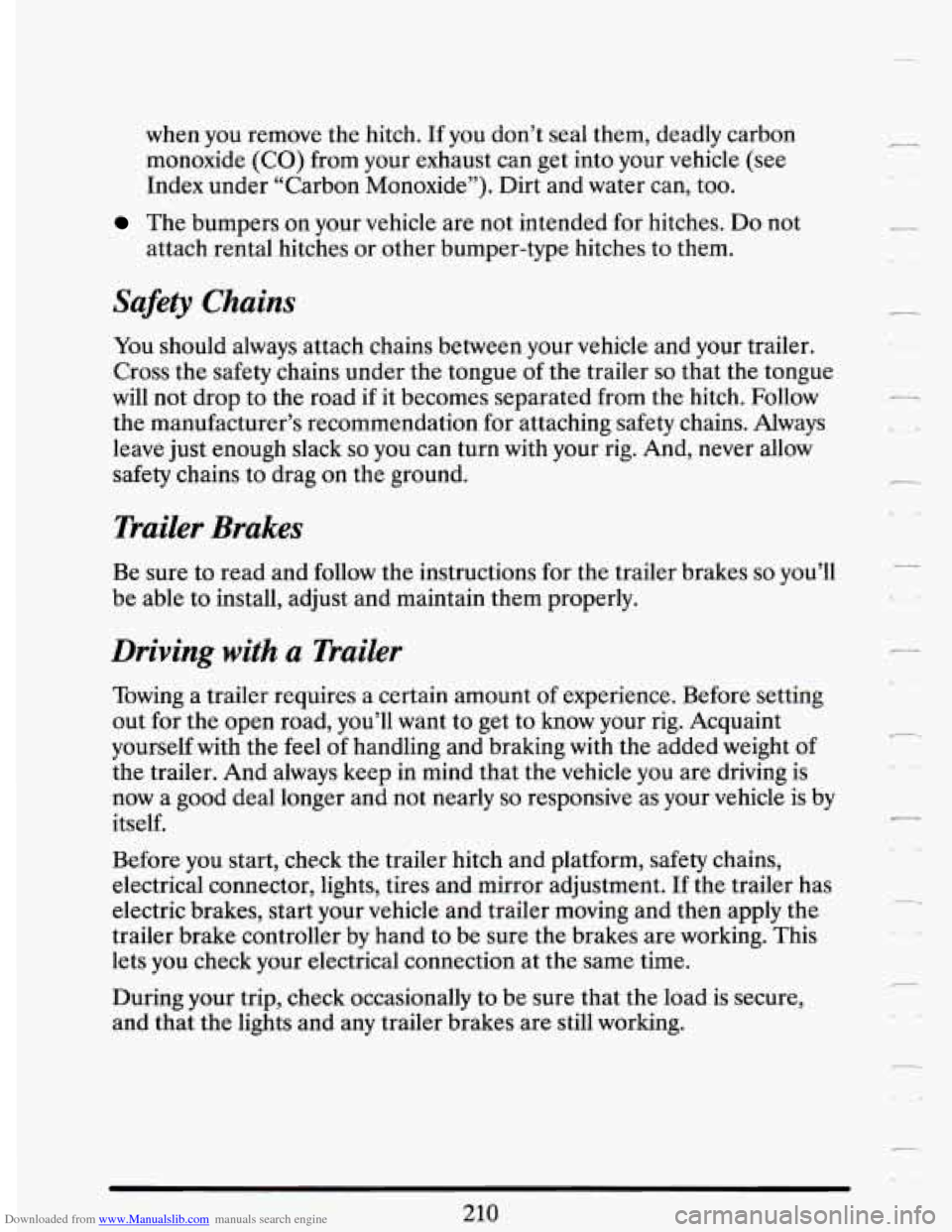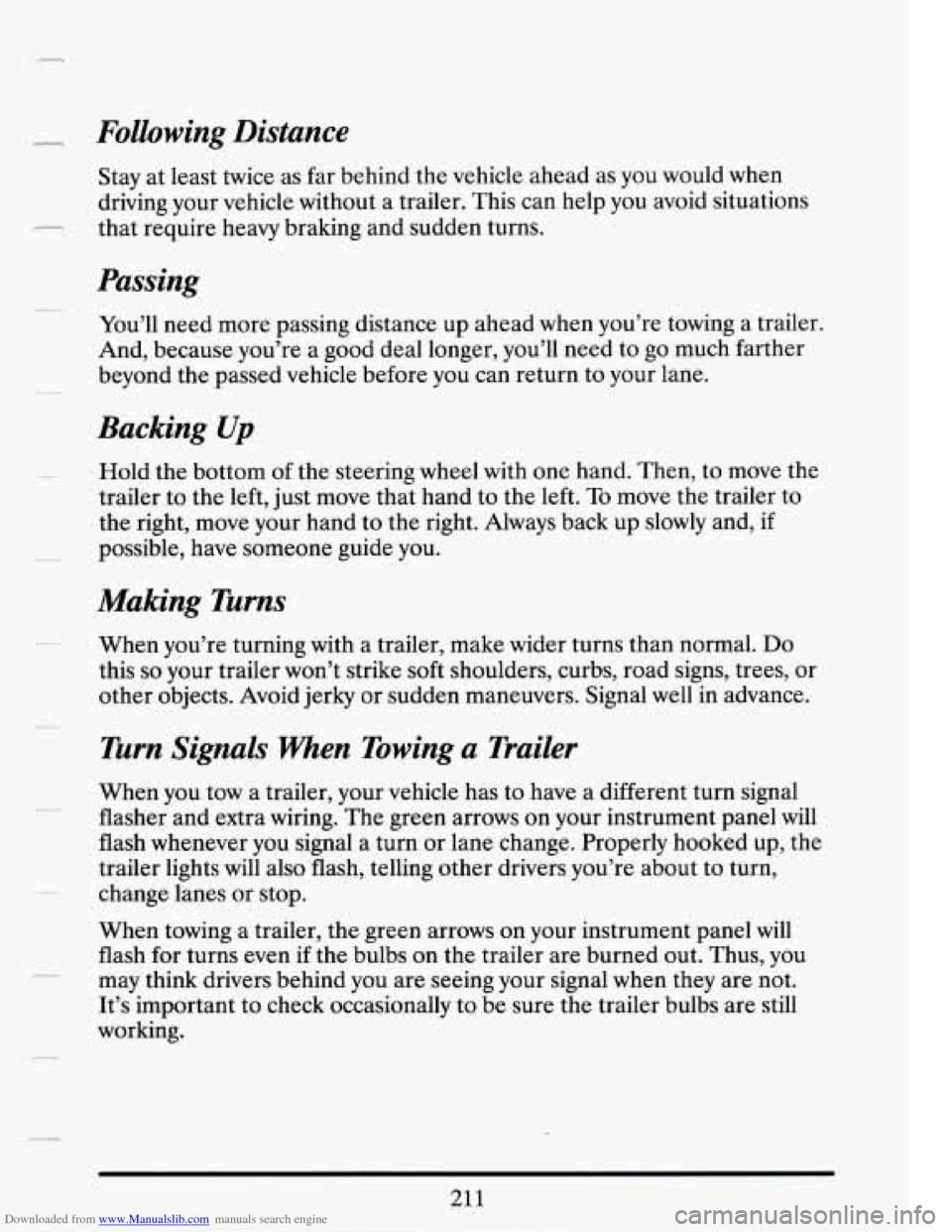CADILLAC DEVILLE 1994 7.G Owners Manual
Manufacturer: CADILLAC, Model Year: 1994, Model line: DEVILLE, Model: CADILLAC DEVILLE 1994 7.GPages: 399, PDF Size: 20.97 MB
Page 221 of 399

Downloaded from www.Manualslib.com manuals search engine If You Do Decide To Pull A Trailer
If you do, here are some important points.
0
0
There are many different laws having to do with trailering. Make sure
your rig will be legal, not only where you live but also where you’ll be
driving. A good source for this information can be state or provincial
police.
You can ask a hitch dealer about sway controls.
Don’t tow a trailer at all during the first
500 miles (800 km) your new
vehicle is driven. Your engine, transaxle or other parts could be
damaged.
Then, during the first
500 miles (800 km) that you tow a trailer, don’t
drive over
50 mph (80 km/h) and don’t make starts at full throttle.
This helps your engine and other parts of your vehicle wear in at the
heavier loads.
When towing a trailer, close all windows and set the Electronic
Climate Control System to “ECON’, “AUTO”, “DEFOG” or
Defroster to assure that the fan is running.
Three important considerations have to do with weight:
1. Weight of the nailer
How heavy can a trailer safely be?
It should never weigh more than
1,000 pounds (450 kg) total,
including the load.
It depends on how you plan to use your rig. For example, speed,
altitude, road grades, outside temperature and how much your
vehicle is used
to pull a trailer are all important. And, it can also
depend on any special equipment that you have on your vehicle.
You can ask your dealer for information or advice, or you can call
us at Cadillac (1-800-43 FLEET).
In Canada, write to General Motors of Canada Limited, Customer
Assistance Center,
1908 Colonel Sam Drive, Oshawa, Ontario LlH
8P7.
208
Page 222 of 399

Downloaded from www.Manualslib.com manuals search engine 2. Weight of the Railer Tongue
When a trailer is connected to your vehicle, the trailer tongue adds
to
the weight your vehicle is carrying. So, remember to subtract the
weight of the trailer tongue from your vehicle’s capacity weight.
--
A
The trailer tongue (A) should weigh 7-10% of the total loaded
trailer weight
(B). After you’ve loaded your trailer, weigh the
trailer and then
the tongue, separately, to see if the weights are
proper. If they aren’t, you may be able to get them right simply by
moving some items around in the trailer.
3. Total Weight on Your Vehicle’s Tires
Be sure your vehicle’s tires are inflated to the limit for cold tires.
You’ll find these numbers on the Certification label at the rear edge
of the driver’s door (or see Index under “Tire Loading”).
Then be
sure you don’t go over the
GVWR limit for your vehicle.
B
Hitches
It’s important to have the correct hitch equipment. Crosswinds, large
trucks going
by, and rough roads are a few reasons why you’ll need the
right hitch. Here are some rules to follow:
Will you have to make any holes
in the body of your vehicle when you
install a trailer hitch?
If you do, then be sure to seal the holes later
209
Page 223 of 399

Downloaded from www.Manualslib.com manuals search engine when you remove the hitch. If you don’t seal them, deadly carbon
monoxide
(CO) from your exhaust can get into your vehicle (see
Index under “Carbon Monoxide”). Dirt and water can, too.
attach rental hitches or other bumper-type hitches to them.
The bumpers on your vehicle are not intended for hitches. Do not
Safety Chains
You should always attach chains between your vehicle and your trailer.
Cross the safety chains under the tongue of the trailer so that the tongue
will not drop to the road
if it becomes separated from the hitch. Follow
the manufacturer’s recommendation for attaching safety chains. Always
leave just enough slack
so you can turn with your rig. And, never allow
safety chains to drag
on the ground.
Trailer Brakes
Be sure to read and follow the instructions for the trailer brakes so you’ll
be able to install, adjust and maintain them properly.
Driving with a Trailer
Towing a trailer requires a certain amount of experience. Before setting
out for the open road, you’ll want to get to
know your rig. Acquaint
yourself with the
feel of handling and braking with the added weight of
the trailer. And always keep
in mind that the vehicle you are driving is
now a good deal longer and not nearly
so responsive as your vehicle is by
itself.
Before you start, check the trailer hitch and platform, safety chains,
electrical connector, lights, tires and mirror adjustment. If the trailer has
electric brakes, start your vehicle and trailer moving and then apply the
trailer brake controller by hand to be sure the brakes are working. This
lets you check your electrical connection at the same time.
During your trip, check occasionally to be sure that the load is secure,
and that the lights and any trailer brakes are still working.
r
c.
.-
r.
Page 224 of 399

Downloaded from www.Manualslib.com manuals search engine Following Distance
--
>-
Stay at least twice as far behind the vehicle ahead as you would when
driving your vehicle without
a trailer. This can help you avoid situations
that require heavy braking and sudden turns.
Passing
You’ll need more passing distance up ahead when you’re towing a trailer.
And, because you’re a good deal longer, you’ll need to go much farther
beyond the passed vehicle before you can return to your lane.
Bucking Up
Hold the bottom of the steering wheel with one hand. Then, to move the
trailer
to the left, just move that hand to the left. To move the trailer to
the right, move your hand to the right. Always back up slowly and,
if
possible, have someone guide you.
Making Turns
When you’re turning with a trailer, make wider turns than normal. Do
this so your trailer won’t strike soft shoulders, curbs, road signs, trees, or
other objects. Avoid jerky or sudden maneuvers. Signal
well in advance.
Turn Signals When Towing a Trailer
When you tow a trailer, your vehicle has to have a different turn signal
flasher and extra wiring. The green arrows on your instrument panel
will
flash whenever you signal a turn or lane change. Properly hooked up, the
trailer lights will also flash, telling other drivers you’re about to turn,
change lanes or stop.
When towing a trailer, the green arrows on your instrument panel
will
flash for turns even if the bulbs on the trailer are burned out. Thus, you
may think drivers behind you are seeing your signal when they are not.
It’s important to check occasionally to be sure the trailer bulbs are still
working. -
21 1
Page 225 of 399

Downloaded from www.Manualslib.com manuals search engine Driving On Grades
Reduce speed and shift to a lower gear before you start down a long or
steep downgrade. If you don’t shift down, you might have to use your
brakes
so much that they would get hot and no longer work well.
On a long uphill grade, shift down and reduce your speed to around 45
mph (70 km/h) or less to reduce the possibility of engine and transaxle
overheating.
If your trailer weighs more than 1,000 pounds (450 Kg) and you have an
automatic transaxle with Overdrive, you may want to drive in “3” instead
of Overdrive.
Parking on Hills
You really should not park your vehicle, with a trailer attached, on a hill.
If something goes wrong, your rig could start to move. People can be
injured, and both your vehicle and the trailer can be damaged.
But
if you ever have to park your rig on a hill, here’s how to do it:
Apply your regular brakes, but do not shift into “P” (Park).
0 Have someone place chocks under the trailer wheels.
When the wheel chocks are in place, release the regular brakes until
Reapply the regular brakes. Then shift into “P” (Park) firmly and
the
chocks absorb the load.
apply your parking brakes.
Release the regular brakes.
When You Are Ready to Leave Afier Parking on a Hill
1. Apply your regular brakes and hold the pedal down while you:
Start your engine;
Shift into a gear; and
Be sure the parking brake has released.
2. Let up on the brake pedal.
212
r
r
.-
r- -
Page 226 of 399

Downloaded from www.Manualslib.com manuals search engine 3. Drive slowly until the trailer is clear of the chocks.
4. Stop and have someone pick up and store the chocks.
Engine Cooling When Trailering
Your cooling system may temporarily overheat during severe operating
conditions such as;
Climbing grades steeper than 4% at ambient temperatures above
90” Fahrenheit (32’Celsius) with a loaded vehicle and trailer.
Stopping after high-speed driving.
Idling for long periods in stop and go traffic.
If “ENGINE
HOT A/C COMPRESSOR OFF” message appears on the
Driver Information Center, do not be alarmed. This is a normal function
designed to reduce the load on the engine and cooling system you can
continue to drive your vehicle.
If “ENGINE COOLANT
HOT” message appears on the Driver
Information Center, pull off to the side of
the road as soon as it is safe to
do so. When the vehicle is at a complete stop, shift the transmission
selector to
P (Park) and allow the engine to idle. Do not turn off the
engine or increase engine speed above a normal idle. Within
two or three
minutes the system should cool sufficiently to allow
A/C operation to
resume. At that
time resume driving at a reduced speed. Return to
normal driving after
10 minutes if the “ENGINE COOLANT HOT”
message
is not displayed.
Maintenance when Trailer Towing
Your vehicle will need service more often when you’re pulling a trailer.
See
the Maintenance Schedule for more on this. Things that are
especially important
in trailer operation are automatic transaxle fluid
(don’t overfill), engine oil, belts, cooling system, and brake wear. Each of
these is covered
in this manual, and the Index will help you find them
quickly. If you’re trailering, it’s a good idea to review these sections
before
you start your trip.
Check periodically
to see that all hitch nuts and bolts are tight.
213
Page 227 of 399

Downloaded from www.Manualslib.com manuals search engine PROBLEMS ON THE ROAD
I
Here you’ll find what to do about some problems that can occur on the
road.
Page 228 of 399

Downloaded from www.Manualslib.com manuals search engine HAZARD WMZNG FLASHERS
Your hazard warning flashers let you warn others. They also let police
know you have a problem. Your front and rear turn signal lights will flash
on and off.
Press the button in to
make your front and
rear turn signal lights
flash on and
off.
Page 229 of 399

Downloaded from www.Manualslib.com manuals search engine The light on your instrument panel will flash indicating that the hazard
warning flashers are on.
Your hazard warning flashers work no matter what position your key is in,
and even
if the key isn’t in.
To turn off the
flashers, pull out
on
the collar. When the
hazard warning
flashers are on, your
turn signals won’t
work.
E3
OTHER WMING DEWCES
E3
If you carry reflective triangles, you can set one up at the side of the road
about
300 feet (100 m) behind your vehicle.
216
Page 230 of 399

Downloaded from www.Manualslib.com manuals search engine JUMP STARTING
If your battery has run down, you may want to use another vehicle and
some jumper cables
to start your Cadillac . But please follow the steps
below
to do it safely.
-
NOTICE:
Ignoring these steps could result in costly damage to your
vehicle that wouldn’t be covered by your warranty.
Trying to start your Cadillac by pushing or pulling it won’t
work, and it could damage your vehicle.
TO JUMP START YOUR CXDILLAC:
1. Check the other vehicle. It must have a 12-volt battery with a negative
ground system.
NOTICE:
If the other system isn’t a 12-volt system with a negative ground,
both vehicles can be damaged.